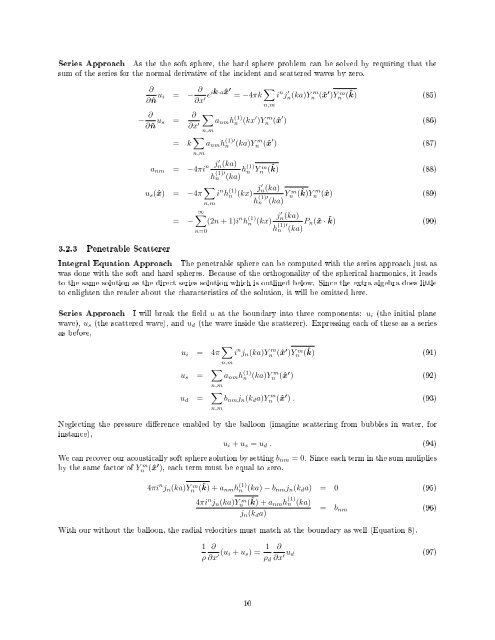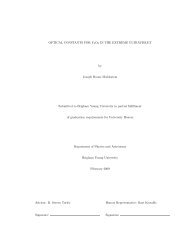Acoustic Scattering from a Sphere - Steve Turley
Acoustic Scattering from a Sphere - Steve Turley
Acoustic Scattering from a Sphere - Steve Turley
You also want an ePaper? Increase the reach of your titles
YUMPU automatically turns print PDFs into web optimized ePapers that Google loves.
Series Approach As the the soft sphere, the hard sphere problem can be solved by requiring that thesum of the series for the normal derivative of the incident and scattered waves by zero.3.2.3 Penetrable Scatterer∂∂ˆn u i = − ∂ eik·aˆx′ ∂x ′ = −4πk ∑ i n j n(ka)Y ′ n m (ˆx ′ )Yn m (ˆk) (85)n,m− ∂∂ˆn u s = ∂ ∑∂x ′ a nm h (1)n (kx ′ )Yn m (ˆx ′ ) (86)= k ∑ n,mn,ma nm = −4πi n j′ n(ka)a nm h (1)′n (ka)Y m n (ˆx ′ ) (87)h (1)′n(ka) h(1)u s (ˆx) = −4π ∑ i n h (1)nn,m∞∑= − (2n + 1)i n h (1)n=0n Y m n (ˆk) (88)(kx) j′ n(ka)h (1)′n (ka) Y m n (ˆk)Y m n (ˆx) (89)n(kx) j′ n(ka)h (1)′n (ka) P n(ˆx · ˆk) (90)Integral Equation Approach The penetrable sphere can be computed with the series approach just aswas done with the soft and hard spheres. Because of the orthogonality of the spherical harmonics, it leadsto the same solution as the direct series solution which is outlined below. Since the extra algebra does littleto enlighten the reader about the characteristics of the solution, it will be omitted here.Series Approach I will break the eld u at the boundary into three components: u i (the initial planewave), u s (the scattered wave), and u d (the wave inside the scatterer). Expressing each of these as a seriesas before,u i = 4π ∑ n,mi n j n (ka)Y m n (ˆx ′ )Y m n (ˆk) (91)u s = ∑ n,ma nm h (1)n (ka)Y m n (ˆx ′ ) (92)u d = ∑ n,mb nm j n (k d a)Y m n (ˆx ′ ) . (93)Neglecting the pressure dierence enabled by the balloon (imagine scattering <strong>from</strong> bubbles in water, forinstance),u i + u s = u d . (94)We can recover our acoustically soft sphere solution by setting b nm = 0. Since each term in the sum mulipliesby the same factor of Y m n (ˆx ′ ), each term must be equal to zero.4πi n j n (ka)Y m n (ˆk) + a nm h (1)n (ka) − b nm j n (k d a) = 0 (95)4πi n j n (ka)Yn m (ˆk) + a nm h (1)n (ka)j n (k d a)= b nm (96)With our without the balloon, the radial velocities must match at the boundary as well (Equation 8).1 ∂ρ ∂x ′ (u i + u s ) = 1 ∂ρ d ∂x ′ u d (97)10





